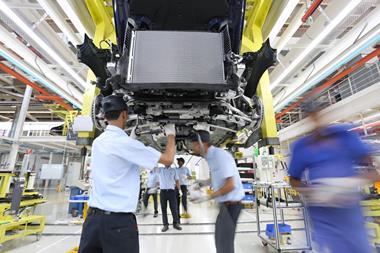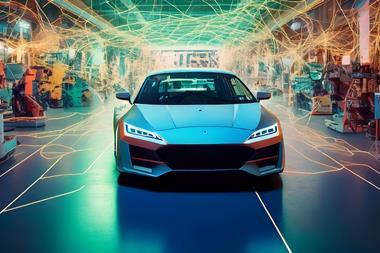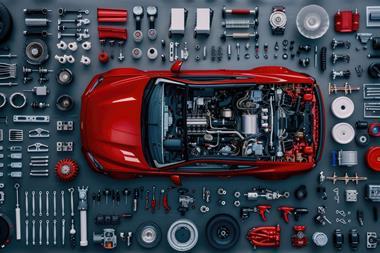As it continues to grow, the Laser World of Photonics exhibition attracts important scientists and engineers as well as exciting new products
The LASER 2007 World of Photonics held in Munich, Germany from 18-21 June achieved its best results since the trade fair began in 1973. There were 1,008 exhibitors, up from 948 in 2005 and an increase of 6.3 per cent. Over 25,000 visitors attended the four-day event, up from the 2005 figure of 23,310.
The World of Photonics Congress also recorded substantial growth figures. Leading scientists from throughout the whole world, including the Nobel winner for Physics 2005, Prof Dr Theodor Hänsch, presented their research results in six conference sessions, which took place under the auspices of the World of Photonics Congress. More than 2,300 speeches and presentations formed part of the event. The congress was organised in conjunction with Messe München International and leading international science societies.
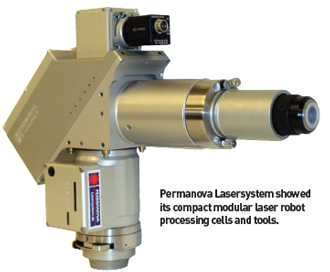 Permanova Lasersystem
Permanova Lasersystem
www.permanova.se
Permanova Lasersystem showed its compact modular laser robot processing cells and tools. Laser cells from Permanova are complete units for laser welding, laser cutting, laser brazing or hybrid laser- GMAW welding. These standardised modular cells can be configured for different customer needs. Plug-and-play operation, with special customer adaptations for fixturing and special purpose software for workshops or general automotive industry (OEMs and Tier 1 suppliers) applications are available.
The new compact Permanova CT06 Cutting Tool System accommodates new fibre and disk laser sources. Among the user features are self calibration, corner compensation, freeze function, soft TCP, logging, temperature supervision and status presentation. Additional tools available are the XYtable (for less precise robots), and the Focus Position System (FPS), allowing a tool calibration check within a few seconds (after robot collisions and so on).
The enhanced Permanova WT03 Welding Tool System was also on display. This system can be configured for several laser processes and geometries, in for example car roof welding and other applications. Its optical ST Seam Tracking option is integrated into the tool. It is useful also for laser brazing and hybrid welding. Latest FindPattern software allows tracking of virtually any geometry.
ACI Laser
www.aci-laser.de
ACI Laser introduced its new high quality Q-switch Nd: YAG laser marking systems. ACI laser marking products can be used for all kind of materials from plastics and metals to ceramics. These systems are small, compact and stable. They can operate singly or can be integrated into production lines.
The actively q-switched solid-state laser marker Nd:YAG provides high-contrast marking on metals, plastics, ceramics and foils. Generally, there are three different kinds of marking: engravings, colour changes, or coatings can be skimmed by ACI’s laser marking systems. This is possible because these materials have high absorption at the emitted wavelength of the laser (1064 nm). With the short-pulse lasers from ACI Laser, the physical and chemical reactions of the materials are effected positively.
Also, unwanted thermal side-effects can be avoided. With lasers, in active marking operation, users have the complete pulse frequency range of 1 - 100 kHz available, which is useful for all three kinds of marking. This allows fast, highquality, durable, flexible labelling, there are no consumables required and even gentle marking is available without applying power.
ACI Laser has created and developed the laser systems to comply with all existing market standards. The result is the integration of all optical, electronic and mechanical components in one case. Options for water cooling, fibre optical connections and high quality electrical supply units provide complete laser marking systems from ACI.
The integrated thermoelectrical cooling system allows for the steady operation of the solid-state laser and allows customers to minimise costs, space and maintenance. The 5 W DPLMagic Marker is characterised by its compact design and is an ideal tool for marking plastic material.
Bystronic Laser
www.bystronic.com
Visitors to the Bystronic exhibition booth were able to see laser cutting, waterjet cutting, bending – in fact, all the sheet metal processes on one stand. They were also able to drop in to the very popular Software Forum advice centre.
The company’s portfolio was represented by two systems: ByVention, the smallest laser cutting machine for standard sheet metal formats, and Byspeed, which, because of its extraordinary dynamics, is one of the fastest and most sought-after machines on the market.
ByVention is simple because it is easy to use; the training required to achieve high quality production results is minimal. It is compact, with a footprint of just six by six metres, thus making the most of available space. Its innovative material flow concept makes the cut parts available immediately and it offers exemplary flexibility when processing material of various sizes as well as skeleton sheets.
The ByVention machine is designed to cut eighty percent of all parts cut by laser cutting machines (that is, sheet thickness of up to 8mm with a format of 500mm x 500mm).
It also cuts dimensions and the material thicknesses that are seldom cut. The result is a previously unachieved efficiency with the lowest possible prices. Compared with other high quality laser cutting machines, the customer gets a machine at around half the normal investment cost, which can process some 80 per cent of all laser cut parts.
The efficient dynamics and superior cutting results are the most striking features of the Byspeed laser cutting machine.
Its extremely high cutting speed and short cycle times turn it into a productivity engine in any workshop. This is ensured by the state-of-the-art cutting technologies and piercing methods.
 OSRAM Opto Semiconductors
OSRAM Opto Semiconductors
www.osram-os.com
In addition to the world’s smallest and first surface mountable high-power laser for continuous wave mode (cw mode), OSRAM Opto Semiconductors presented watercooled vertical laser stacks and laser bars in standard “CS mount” casings for the first time in Europe. Passively and actively cooled SIRILAS units round off the high-power portfolio.
As an SMT (surface mount technology) component the high-power laser for continuous wave (cw) mode is compatible with modern production processes such as reflow soldering. The laser is dust-proof, powerful and cost-effective, making it particularly useful for volume applications in the automotive sector and medical systems. It is robust, powerful and capable of withstanding harsh ambient conditions in industrial applications and in automobile environments.
This tiny 2.5mm high laser has a footprint of only 6.0mm x 4.5mm. The dustproof, electrically insulated package has a small thermal resistance of just about 2.5 KW. This compact laser emits all its light upwards using a prism, at a wavelength of 810 nm and it is designed for an output of up to 6W. It can therefore be placed anywhere on a circuit board, not just at the edge. Its base has good thermal conductivity so if it is soldered directly on a metal core board its heat loss can be removed extremely efficiently.
Typical uses include volume applications such as night vision systems, traffic monitoring and medical equipment. Passive cooled laser diodes on solid copper heat sinks (CS mounts) offer optical outputs of up to 50 W in continuous wave mode. They are used wherever watercooling is not possible, for example in transportable systems for medical applications.
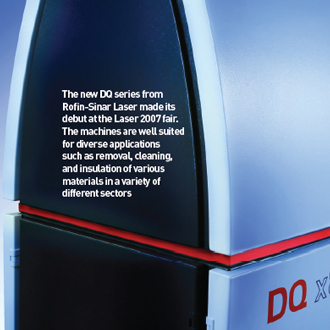 ROFIN-SINAR Laser
ROFIN-SINAR Laser
www.rofin-sinar.com
ROFIN-SINAR Laser presented its new high power DQ series of solid state lasers for the first time at Laser 2007.
Based on the successful diode pumped Nd:YAG lasers, Rofin has developed the new DQ series that is well suited for diverse applications such as removal, cleaning, and insulation of various materials in different markets. The Q-switched lasers, available as Standard, Premium and Premium+, differ in power, pulse energy and equipment.
This new technology offers varied opportunities: the removal of any metallic coating of tailored blanks, the insulation of solar cell edges, the machining of flat screens or activating surfaces.
The beam is carried safely and flexibly to the application point by fibre optics of 600 nm (Standard and Premium) and 800 nm (Premium+). A new square fibre provides the highest efficiency for surface treatment applications.
Compared with a round fibre, a square fibre can handle up to 51 per cent larger surfaces per pulse. Due to the square geometry, large areas are processed more efficiently when overlapped.
TRUMPF Laser
www.trumpf-laser.com
The first trade show day for the TRUMPF Group at the Laser 2007 resulted in an order of a number of disk lasers from vehicle maker DaimlerChrysler. The disks will be used for the welding of body components. DaimlerChrysler already uses disk lasers for ‘remote’ welding. The company decided to increase its investment in disk lasers as they give reliability and flexibility when welding car components.
A programmable focusing optics (PFO), a scanner optics for laser welding, is integrated into a robot for remote welding. Mirrors position the laser beam extremely fast to any position within the processing field. This enables spot and seam welding without having to move the work piece or the focusing optics. In addition to the disk lasers, DaimlerChrysler also ordered several PFO from TRUMPF.
Work can be done in a 3D workspace and with three fast axes for stationary optics.
JENOPTIK Automatisierungstechnik
www. jenoptik.com
Jenoptik introduced new developments with high-speed diode lasers. The conversion of its product range to high efficiency diode laser ingots began more than two years ago.
This transition brings the efficiency of these kinds of lasers into the range that could only be achieved hitherto with high-speed diode lasers with micro-channel heat sinks. In the past the use of micro-channel heat sinks as high efficiency radiator boxes opened new applications for diode lasers. These were accompanied by stringent requirements with regard to the cooling water quality.
Jenoptik’s new solution - the industrial water stack – whose cooling no longer requires deionised water. This opens up new possibilities for the user and increases the life expectancy in industrial applications.
The industrial water stack is offered in many different configurations to optimise the use of certain high speed diode lasers. Also new is a line of single and multi-emitter diode lasers, which opens up new possibilities in particular in the lower capacity range for final-pumped DPSSL (Diode Pumped Solid State Laser).































